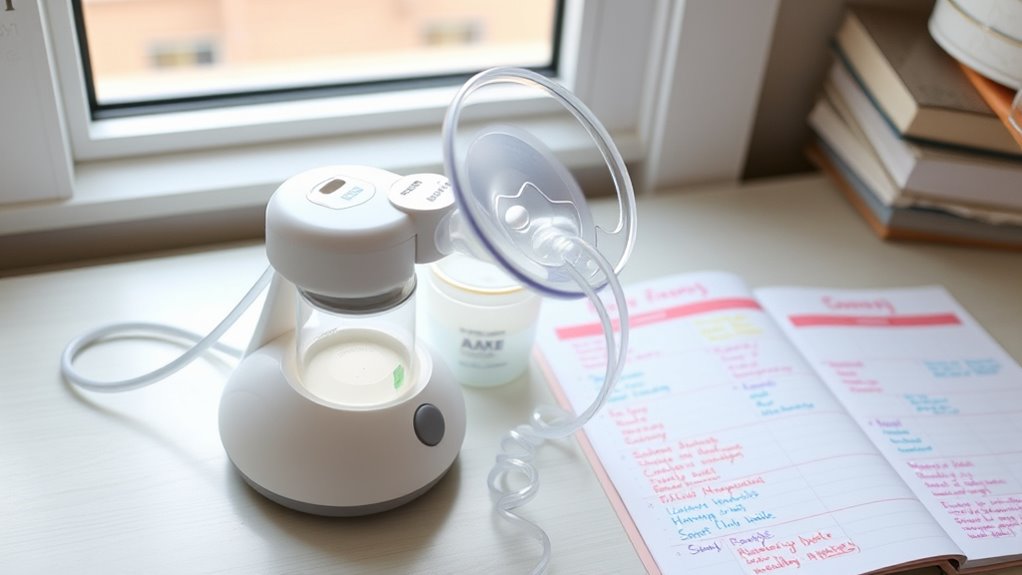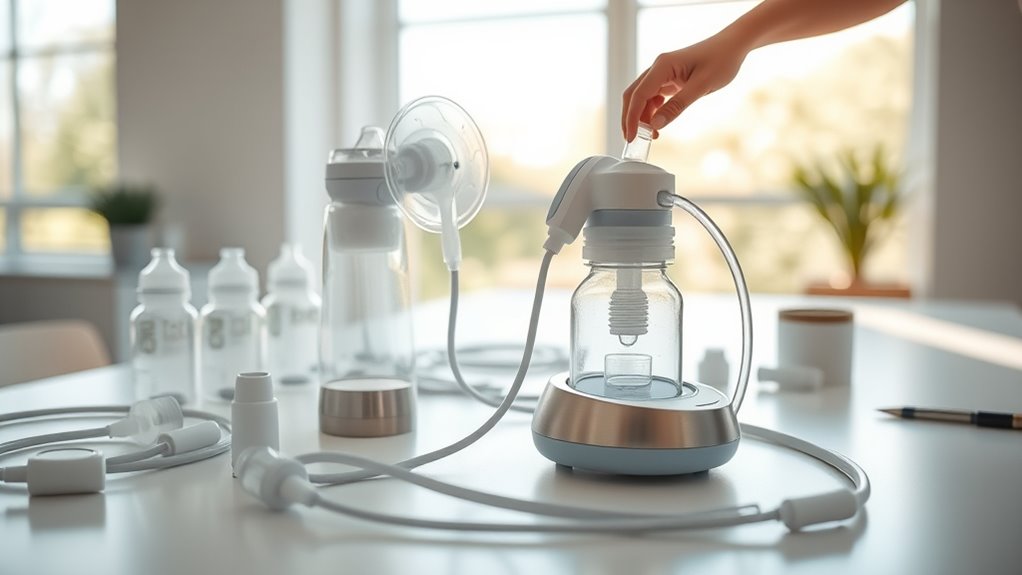When returning to work, assess your environment for private, comfortable pumping spaces and make certain you have the necessary equipment like a reliable breast pump and storage containers. Develop a flexible schedule that aligns with your work breaks, and communicate your needs clearly with your employer. Stay comfortable by wearing supportive bras and keeping your equipment clean. To build an effective plan that works for you, learn more about creating a personalized pumping routine and tips to support your milk supply.
Key Takeaways
- Evaluate your workspace for privacy, comfort, and necessary resources like a clean sink and refrigerator.
- Develop a flexible pumping schedule aligned with work breaks, tracking sessions to maintain milk supply.
- Choose and maintain appropriate pumping equipment, ensuring cleanliness and replacing worn parts regularly.
- Communicate your pumping needs clearly with your employer and team to secure private space and break times.
- Prioritize comfort and hydration, using supportive gear and relaxation techniques to support milk production during work.
Assessing Your Work Environment and Resources

Before returning to work, evaluating your current work environment and the resources available to you is essential. Look around your workspace—are there private, comfortable areas where you can pump? Check if you have access to a clean sink or refrigerator to store your milk safely. Consider your schedule—will you have enough breaks to pump comfortably? Think about the equipment you need; do you have a reliable breast pump and storage containers? Identify any obstacles, like noisy or shared spaces, that might make pumping difficult. Knowing what resources are available helps you plan realistically. Being aware of your environment allows you to advocate for a suitable space and gather the tools necessary to maintain your milk supply confidently. Additionally, understanding self watering plant pots can serve as a helpful analogy for managing your pumping schedule efficiently.
Developing a Personalized Pumping Schedule

How can you create a pumping schedule that fits seamlessly into your daily routine? Start by estimating how often you’ll need to pump—generally every 2-3 hours during work hours. Consider your work schedule, break times, and lunch period to identify natural gaps. Be flexible; your initial plan might need adjustments as you discover what works best. Prioritize consistency to maintain your milk supply and prevent discomfort. Keep track of your pumping sessions in a journal or app, noting times and durations. This helps you identify patterns and make necessary tweaks. Remember, your schedule should support your workload and personal comfort, not add stress. Additionally, understanding how high-quality equipment can influence your pumping efficiency is beneficial. With a personalized plan, you’ll feel more confident balancing work responsibilities and your breastfeeding goals.
Selecting and Maintaining Your Pumping Equipment

Choosing the right pumping equipment and keeping it in good shape directly impacts your milk supply and comfort. Start by selecting a pump that fits your needs—double or single, electric or manual—based on your work schedule and pumping frequency. Look for models with adjustable suction and speed settings to enhance comfort. Regularly clean your parts according to manufacturer instructions to prevent bacteria buildup and ensure ideal milk flow. Replace worn-out parts like valves and membranes to maintain suction strength. Store your pump and accessories in a clean, dry place when not in use. Proper maintenance prevents malfunctions and extends your equipment’s lifespan. Investing time in choosing quality gear and caring for it makes pumping more efficient and comfortable, supporting your return to work and breastfeeding goals. Additionally, paying attention to routine cleaning and replacement of parts is essential for maintaining the pump’s functionality and your peace of mind.
Communicating Your Needs With Your Employer and Team

Effective communication with your employer and team is essential to guarantee your pumping needs are understood and supported. Be clear about your schedule, specifying when you need break times and private space for pumping. Share your plan early, so your team can accommodate your requirements smoothly. It helps to explain why pumping is important for your health and your baby’s well-being. Keep your tone professional yet assertive, and don’t hesitate to ask for specific arrangements if needed. Maintaining open dialogue encourages understanding and flexibility. Remember, your employer has a legal obligation to support your breastfeeding needs. By communicating openly, you foster a supportive environment that allows you to balance work responsibilities with your pumping schedule confidently. Being aware of newborn feeding options can also help you explain your needs more effectively.
Tips for Staying Comfortable and Supporting Your Milk Supply

Once you’ve communicated your pumping needs clearly with your employer and team, focusing on your comfort and milk supply can make the process more manageable. Invest in a supportive, well-fitting bra to prevent discomfort and promote better milk flow. Use a hands-free pumping bra to stay comfortable and multitask if needed. Keep your pump parts clean and well-maintained to prevent infections and ensure efficient pumping. Stay hydrated and eat nutritious meals to support your milk production. Take short breaks during your workday to relax and reset, which can help maintain your supply. If you’re feeling sore or engorged, try gentle massage or warm compresses to soothe discomfort. Prioritizing self-care and staying relaxed will help you stay comfortable and keep up your milk supply. Additionally, understanding milk ejection reflex techniques can enhance your pumping efficiency and comfort.
Frequently Asked Questions
How Do I Handle Unexpected Work Deadlines While Pumping?
When faced with unexpected work deadlines while pumping, stay calm and flexible. Quickly assess your supply needs and prioritize your pumping sessions. If possible, communicate with your employer about adjusting your schedule or taking short breaks. Keep your pump and supplies handy, and try to pump a little extra when you can. Remember, staying proactive and adaptable helps you manage stress and maintain your milk supply effectively.
What Legal Rights Protect My Breastfeeding Needs at Work?
Your legal rights are like a shield protecting your breastfeeding needs at work. Under laws like the Fair Labor Standards Act, you’re entitled to reasonable break time and a private space to pump. Employers must accommodate your needs without penalty. If you face discrimination or denial, you can seek recourse through the Equal Employment Opportunity Commission. Know your rights, speak up confidently, and advocate for yourself—your health and your baby’s well-being depend on it.
How Can I Manage Pumping During Long Meetings or Travel?
Managing pumping during long meetings or travel can be challenging, but you can plan ahead. Bring your portable breast pump and supplies, and notify your employer in advance to schedule breaks. During meetings, discreetly use a private space or a designated lactation room. When traveling, prioritize your pumping schedule to maintain your milk supply. Staying organized and communicating your needs helps you balance work demands and breastfeeding goals effectively.
What Should I Do if My Employer Is Unresponsive to My Pumping Requests?
You might wonder if your employer will respond to your pumping requests. It’s true that some workplaces delay or ignore these needs, but you can take action. Communicate clearly in writing, reiterate your rights under the law, and stay professional. If needed, seek support from HR or legal advisors. Consistent, respectful follow-up often encourages employers to respect your needs and create a supportive environment.
How Can I Maintain Milk Supply When Returning Part-Time or Flexibly?
To maintain your milk supply when returning part-time or flexibly, you should pump regularly, even during your off days, to keep your supply steady. Stay consistent with your pumping schedule, mimicking your baby’s feeding times as closely as possible. Hydrate well and eat nutritious foods to support milk production. Communicate your needs with your employer if possible, and consider using a hands-free pump to make pumping easier during flexible work hours.
Conclusion
Creating a pumping plan is like planting a seed—you nurture it with care, patience, and consistency. By evaluating your environment, developing a schedule, choosing the right equipment, and communicating your needs, you set the stage for success. Remember, your dedication is the key that unfastens a smooth transition back to work and a healthy milk supply. Stay flexible and confident—your breastfeeding journey is a marathon, not a sprint.









